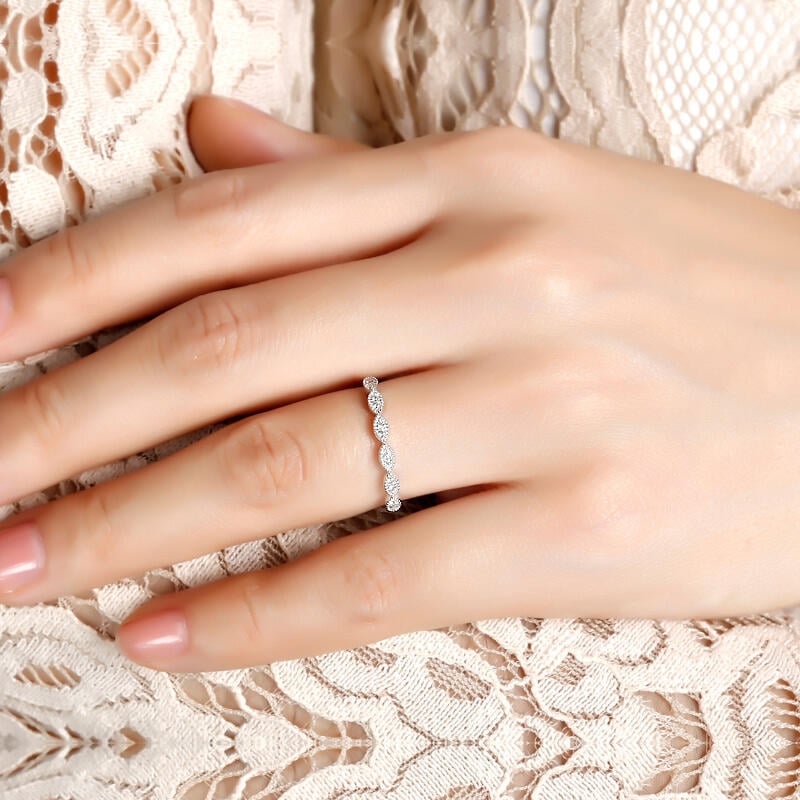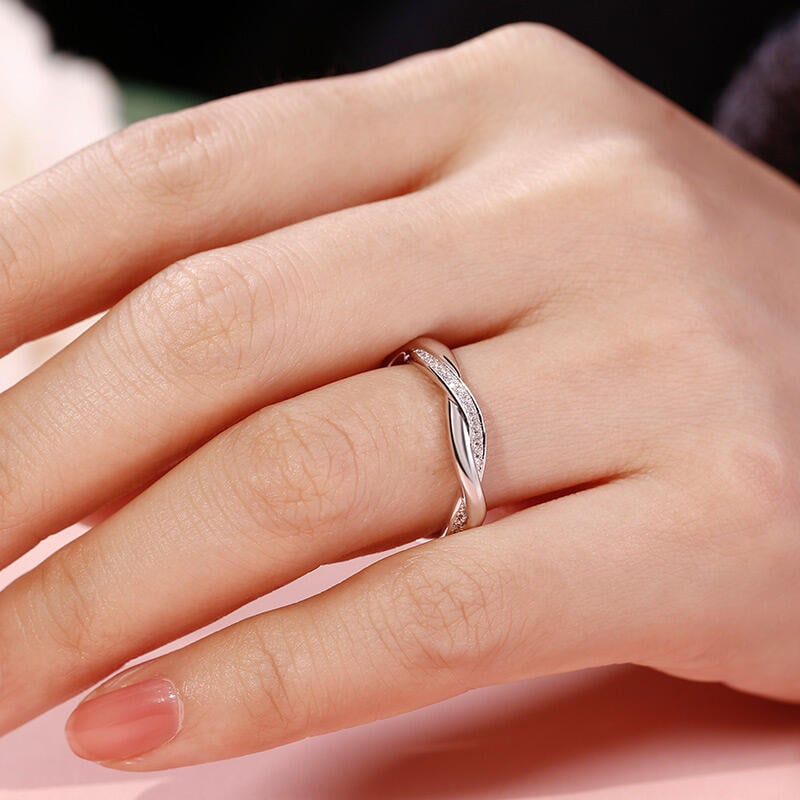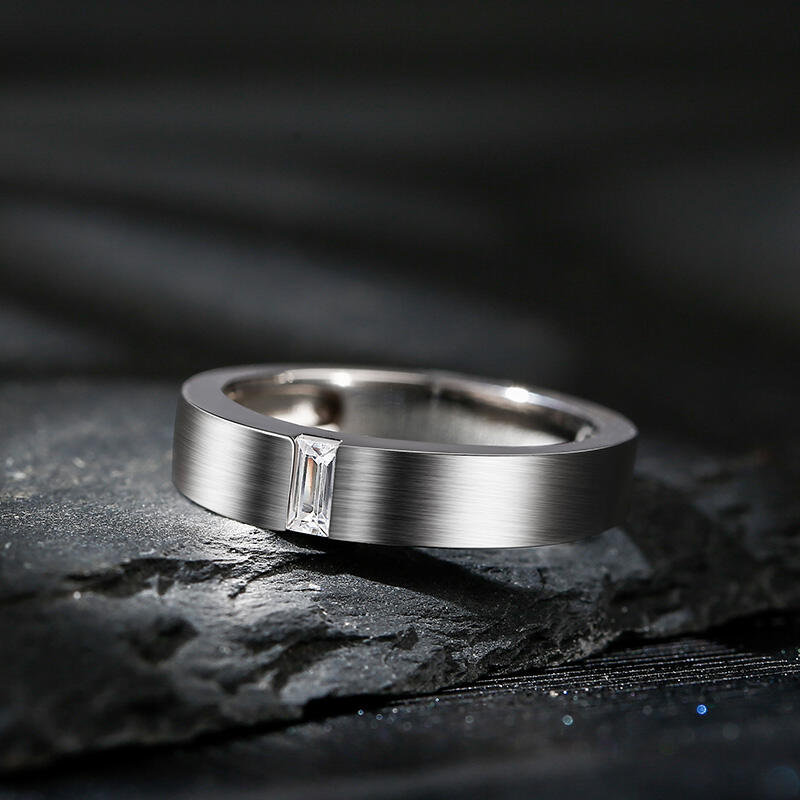The choice between platinum vs. white gold wedding band is a fundamental decision in selecting your forever ring. While they might look identical at first glance, these two metals differ significantly in composition, cost, and maintenance. This article provides a clear comparison to equip you with the knowledge needed for this important decision.
Navigate to:
Platinum vs. White Gold Wedding Band: What Are They?
Before diving into the pros and cons, let’s quickly define what sets these two metals apart.
1. Platinum (Pt)
Platinum is a naturally white, rare precious metal. It is renowned for its purity—jewelry is typically composed of 90–95% pure platinum. This density makes it heavy, durable, and truly hypoallergenic.
2. White Gold (Au)
White gold is an alloy, meaning it is made by mixing pure yellow gold with other white metals (like palladium, silver, or nickel) to lighten its color. Because pure gold is 24K and too soft for everyday wear, engagement rings are usually 14K (58.3% gold) or 18K (75% gold).
The final step in creating white gold jewelry is coating it with a thin, bright layer of a rare metal called Rhodium. This coating is what gives white gold its immediate, brilliant white reflection.
Platinum vs. White Gold Wedding Band Side-by-Side Comparison
| Feature | Platinum (Pt) | White Gold (14K/18K) |
|---|---|---|
| Purity | High (90%–95%) | Low (58%–75% gold) |
| Color | Naturally white (never yellows) | Needs Rhodium plating |
| Cost | High (Premium Price Point) | Moderate (Budget-Friendly) |
| Maintenance | Low (Patina develops; polish as needed) | High (Requires professional Rhodium re-dipping every 1-3 years) |
| Density/Weight | Heavy and Substantial | Light and Comfortable |
| Wear | Metal is displaced (forms a patina) | Metal wears away (gets thinner) |
| Allergies | Hypoallergenic | Often contains nickel (potential irritant) |
| Longevity | Excellent for preserving heritage | Excellent, but requires periodic maintenance |
Pros and Cons of Platinum Wedding Band
Platinum is the prestige choice for a reason. It is often seen as the metal of heritage—a selection meant to be passed down through generations.


Pros of Platinum
- Hypoallergenic & Pure: Because platinum is typically 95% pure, it rarely contains the alloys (like nickel) that trigger skin sensitivities. It is the best choice for anyone with metal allergies.
- The Patina of Age: Platinum is incredibly dense and durable. When it gets scratched, the metal is not lost but merely displaced across the surface, creating what jewelers call a patina. This matte, soft finish is highly coveted and can be polished back to a high shine if desired.
- Unmatched Security: Due to its density, platinum holds diamonds and complex settings more securely than gold. Prongs made of platinum are less likely to break or bend, offering superior protection.
- Maintenance-Free Color: Platinum is naturally white. It will never yellow or require future plating to maintain its color.
Cons of Platinum:
- Higher Cost: Platinum is significantly rarer and denser than gold, making it heavier and usually 40–80% more expensive than 14K or 18K white gold.
- Develops a Patina: While many love the subtle, softened look of the patina, those who prefer an ultra-mirror-like shine at all times will need to get their ring professionally polished more often.
- Heavy Feel: Some wearers find the substantial weight of a platinum ring less comfortable, especially in larger settings.
Pros and Cons of White Gold Wedding Band
White gold is the choice for the practical romantic. It provides the sought-after cool, white look while offering flexibility in budget and initial shine.
Pros of White Gold:
- Affordability: White gold is generally the more budget-friendly option. It offers a spectacular look at a lower price point, leaving more room in the budget for a larger center stone.
- High Brilliance: Thanks to the Rhodium plating, white gold rings boast a spectacularly bright, mirror-like finish when they are new.
- Lighter Weight: White gold is easier and lighter to wear than dense platinum, which many people find more comfortable for daily use.
Cons of White Gold:
- Requires Maintenance (Re-Dipping): This is the single biggest factor to consider. Rhodium plating is very thin and will eventually wear down (especially on the bottom of the band and prongs), exposing the slightly yellowish hue of the gold alloy underneath. Depending on the wearer’s chemistry and lifestyle, the ring will need to be professionally re-dipped every 1–3 years.
- Not Truly Hypoallergenic: Since white gold is an alloy, it frequently contains nickel, which is a common skin irritant. Note: You can opt for a Palladium-based white gold alloy, which is more expensive but typically hypoallergenic.
- Wears Away: When white gold is scratched or heavily worn, tiny bits of the metal are actually removed, making the band thinner over decades of wear.
Platinum vs. White Gold Wedding Band: How to Choose
The “best” metal isn’t about quality; it’s about priorities. Here is our advice for making your final decision:
Choose Platinum If…
- Your Priority is Purity and Security: You have sensitive skin, want the most secure setting for a large diamond, or are looking for the most hypoallergenic option available.
- Your Lifestyle is Active: You want a ring that can withstand heavy wear without losing material, and you don’t want to worry about yellowing.
- You Prefer Low Maintenance: You absolutely do not want to deal with annual trips to the jeweler for Rhodium plating.
Choose White Gold If…
- Your Priority is Budget: You want a beautiful, classic white look and would rather allocate more of your budget toward the size or quality of the diamond.
- You Love High Shine: You prefer a truly brilliant, mirror-like finish and don’t mind the minor maintenance required to restore the Rhodium layer every few years.
- You Prefer Lightweight Jewelry: You find heavy rings cumbersome and prefer a metal that feels lighter on the hand.
When considering Platinum vs. White Gold Wedding Band or engagement rings, the ideal choice ultimately depends on your priorities. Both are exceptional metals that beautifully enhance a diamond’s brilliance. Your decision should align with your lifestyle, budget, and vision, ensuring this treasured piece becomes a perfect symbol of your love.
More Jeulia Post:
White Gold vs. Sterling Silver: Unveiling the Distinctions
14k vs. 18k Rose Gold Engagement Ring
Will My Rose Gold Ring Lose Its Rosy Glow? Understanding Fading and How to Keep it Radiant



